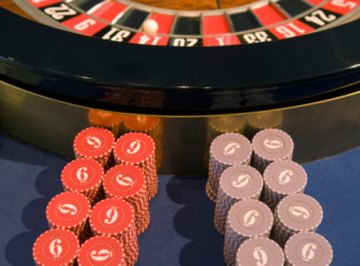
Educators can use spinners as a simple but effective "hands-on" tool to teach some basic lessons in probability. You can make a simple spinner by placing a moving arrow in the middle of a sheet of paper and drawing in a series of equally spaced colored sections around it, or use an electronic spinner on the Internet. Spinners demonstrate that the probability of a particular result from an action is the ratio of how many possible outcomes give you that result over the number of all possible outcomes. You can also use two spinners to teach students about the probability of combined independent events.
You can demonstrate your calculations are correct by spinning the arrows many times and tabulating the results. Over many trials, the ratio of each color being chosen should equal the predicted probability.
Examine the two spinners. Most spinners used to teach probability have a central arrow that spins around to point to one of a number of colored or numbered sections around the perimeter of the spinner. Count how many of these different segments there are around each spinner.
Divide one by the number of different segments around each spinner. This is the probability that the arrow will land on any given section on a single spin. For example, if one spinner has four colored sections (red, blue, yellow and green) around its perimeter, and another has three sections (red, blue and yellow), the probability of landing on any given color for the first spinner is 1/4 and for the second is 1/3. So for the first spinner, the probability of the arrow pointing to blue on a spin is 1/4, the probability of it pointing to green is 1/4 and so on. This assumes that each section is the same physical size.
Multiply the probabilities just calculated for each individual spinner together to find the probability of getting any specific combination of outcomes from spinning the arrows on both spinners. In the example, you would multiply 1/4 by 1/3 to obtain 1/12. This is the probability of the first spinner arrow pointing to green and the second spinner arrow pointing to blue, or the first pointing to yellow and the second to yellow, or any other particular combination of colors. Note that although it may seem unexpected, the combination of two identical colors is just as likely as any other combination. This is because the two wheels are statistically independent, meaning that the result of one does not affect the result of the other.
Tips
References
Tips
- You can demonstrate your calculations are correct by spinning the arrows many times and tabulating the results. Over many trials, the ratio of each color being chosen should equal the predicted probability.
About the Author
Michael Judge has been writing for over a decade and has been published in "The Globe and Mail" (Canada's national newspaper) and the U.K. magazine "New Scientist." He holds a Master of Science from the University of Waterloo. Michael has worked for an aerospace firm where he was in charge of rocket propellant formulation and is now a college instructor.
Photo Credits
Jupiterimages/Goodshoot/Getty Images
